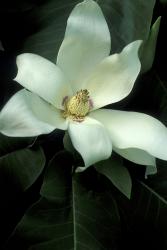Half of all magnolia species are threatened with extinction in the wild. They are found around the globe and are mainly threatened by logging activity as well as habitat loss due to land conversion to agriculture. The Missouri Botanical Garden will be planting 12 different magnolia species in the new landscape around the Jack C. Taylor Visitor Center, including rare and endangered species.
Magnolia acuminata is a large magnolia tree commonly known as cucumber magnolia. It is native to eastern North America, reaching its largest size in the southern Appalachian region. It is the only magnolia native to Missouri. Unlike most magnolias, the flowers are not showy. It is named for the green, warty, cucumber-like fruits that follow the flowers.
Magnolia ashei is a rare, small, deciduous magnolia with very large leaves and attractive white flowers. It is considered the rarest species of magnolia in North America and is restricted to scattered sites in the Florida panhandle. This tree is already planted in the south landscape.
Magnolia tripetala, commonly known as umbrella magnolia, has leaves that appear in whorl-like clusters at the stem tips resembling the spokes of an umbrella. Magnolia tripetala is a widespread species, occurring from Florida to Massachusetts and west to Oklahoma. Although secure through much of its range, it is restricted to relatively small, relictual, mesic habitats in its southwestern range. The smaller, disjunct populations that occur in Oklahoma, Arkansas, Mississippi and Florida do face a number of threats. The biggest threat these populations face may be global climate change and its impacts, but they are also at risk due to the nature of the small scattered populations, limited gene flow, development and land clearing.
The Missouri Botanical Garden is actively working on an ex situ conservation project involving Magnolia tripetala, funded by the American Public Garden Association and United States Forest Service Tree Gene Conservation Partnership, establishing a living gene bank for under-represented populations of this species.







